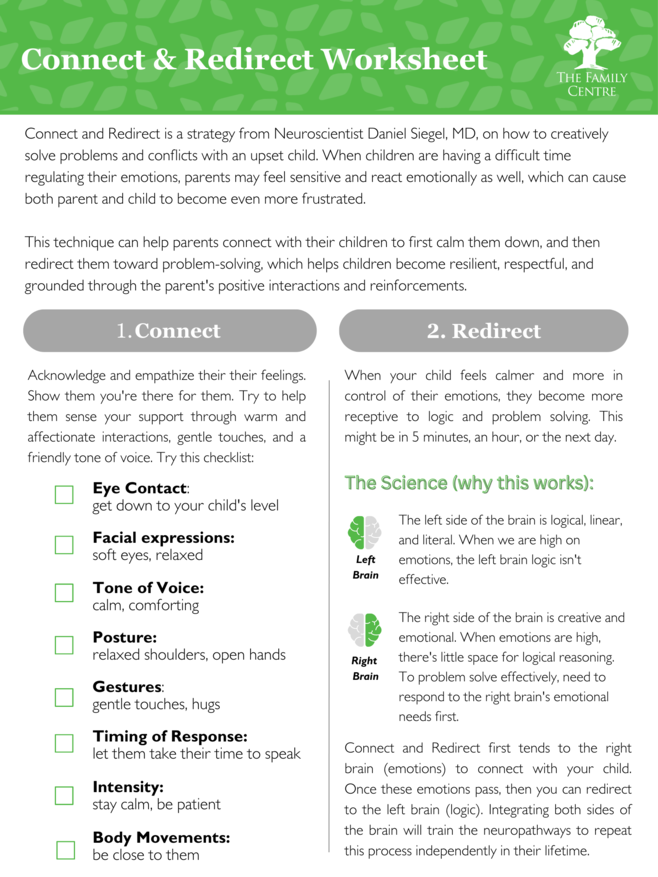Connect and Redirect: Try This to Calm Down Your Child When They Are Emotionally Overwhelmed

Do you know how to respond when your child is having an emotional meltdown? Are you able to calm them down fairly easily? Do you both feel good about your interaction afterwards?
When a child is upset, they might be doing some of the following to signal to you that they’re having a hard time:
• Screaming
• Crying
• Throwing things
• Hitting
• Lashing out verbally
• Whining
• Hurting self or others physically
• Seething anger
• Refusing to communicate
• Slamming doors
• Sulking
• Sarcasm
• Flushed face
• Clenched fists
• Stomping feet
• Rolling eyes
• Loss of language (groans, grunts)
• Physical complaints (stomach aches, headaches)
How do you typically react?
Common Caregiver Responses
A typical response is to offer logic and focus on facts and solutions. It might sound something like,
“Don’t worry! There’s nothing to be afraid of.”
“There’s no reason to cry. Losing is part of the game.”
“Homework is your job. Just get it done. If you focus, you’ll be finished sooner.”
There is nothing wrong with a logic-based response – except that it usually does not work when a child is upset. Instead, both the caregiver and the child will likely be even more frustrated.
Some parents may react emotionally when their child is upset. The positive about this is that you’ll have an emotional connection with your child. The downside is that if you are also very sensitive, you can overwhelm your child with emotions, and you aren’t supporting your child’s feelings.
If you want your child to learn how to manage their emotions, and solve conflicts and problems creatively, there is a better way to respond.
A Recommended Response
So what can you do?
Neuroscientist Daniel Siegel, MD, offers quite a simple strategy. He calls it “connect, redirect” in his book The Whole-Brain Child (available at public libraries).
When your child has strong emotions, connect with your child first to calm them. Once you have made a connection with your child, you can then redirect to problem-solving the issue that made them upset.
This strategy helps in that immediate situation, and it also teaches your child how to deal with similar situations in the future. It helps your child to become resilient, kind, and respectful. It also grows your relationship with your child because you’re connecting through positive interactions.
How Does Connect, Redirect Work?
Step 1: Connect
Connecting means acknowledging and empathizing with your child’s feelings in a nonjudgmental way (even if you don’t approve of their behaviour). Show your child that you are there for them in this difficult moment. Words aren’t enough - your child must sense that your interaction is warm and affectionate for a connection to happen. You can try empathetic facial expressions, gentle touches, and a friendly tone of voice.
Once you are feeling what your child is feeling, listen to your child. Don’t explain, lecture, or try to talk them out of their feelings. Just listen.
Ways to create connection include:
• Eye contact: get down to your child’s level (or below) and look into their eyes while you talk
• Facial expression: soft eyes, relaxed face
• Tone of voice: soft, comforting, calm
• Posture: relaxed shoulders, open hands
• Gestures: gentle touches, offer hugs
• Timing of response: let the child finish before speaking, ask questions
• Intensity of response: stay calm, be patient
• Bodily movement: come closer to your child
Let’s say that your child is throwing things and slamming doors. If you just ask your child not to throw things and slam doors, your child might feel dismissed and that you are minimizing their feelings. They shut down or become even more agitated.
A connect and redirect response could look like this: go near your child and say something like “You seem upset” in a comforting tone. Go down to their eye level, make them feel comfortable, and listen to what they have to say. They will feel supported and talk through their anger.

https://www.familycentre.org/public/download/files/233293
Step 2: Redirect
Only when your child has settled enough, they can handle a logical approach and problem solve the issue. Wait until your child is feeling calmer and more in control of themselves. It might be 5 minutes, and hour, or the next day.
Maybe your child who was throwing things had trouble finishing their homework. Once they feel in control of their emotions, you can help them figure out what to do about their homework.
Why Does This Approach Work?
If you’re interested in learning the science behind this parenting strategy, here’s an explanation.
It’s all about how our brains work. Our brains have two hemispheres, the left and the right. They are connected through a pathway of nerves.
The left side of the brain is logical, linear, and literal. The left brain logic isn’t effective when a child is in the middle of a meltdown.
The right side is the creative and emotional side; it is able to sense emotions and non-verbal communication. When your emotions take over, it leaves little space for the logical reasoning of the left brain. You need to respond to the right brain’s emotional needs first.
When someone diminishes your problem or tells you how to solve it, when all you really need is empathy, it makes you disconnected from them.
The connect, redirect strategy first uses your right brain (empathy) to connect with your child. Once your child isn’t emotionally flooded, you can redirect to the left brain (logic). You are now integrating both sides of your child’s brain, training those neuropathways to repeat this independently at some point in your child’s life.
The key is to integrate the two sides of the brain.
Practice Makes It Easier
Are you encouraged to give connect, redirect a try? The more you see your child responding positively to it, the more likely you are to use it again. And the more you practice using it, the more it will become one of your default responses when your child is having a hard time.
Read more parenting tips on our blog: Raising the Strong-Willed Child, What To Do When Your Child Lies, Should You Let Your Child Face Consequences?
exclusively written for familycentre.org
by Jessica Tran
